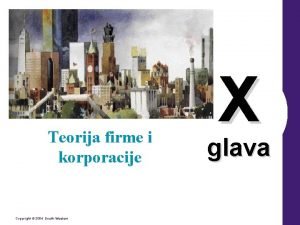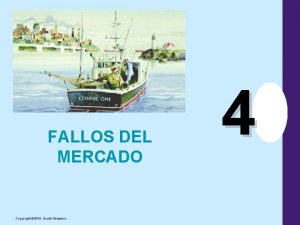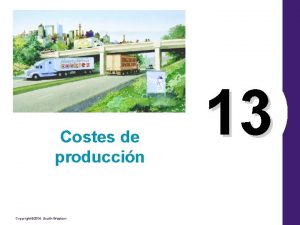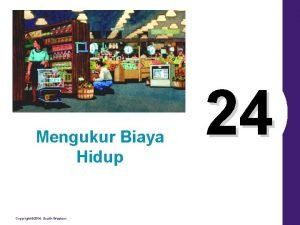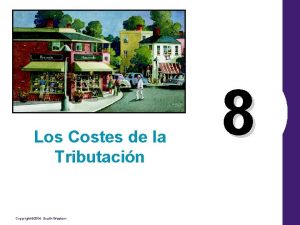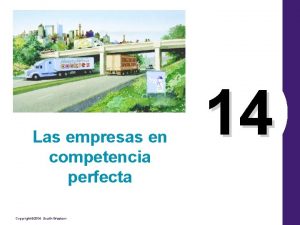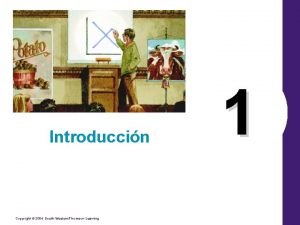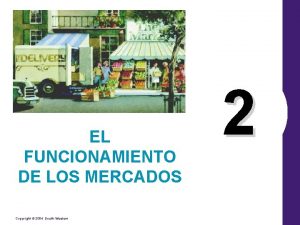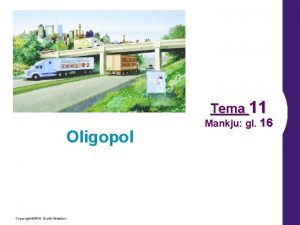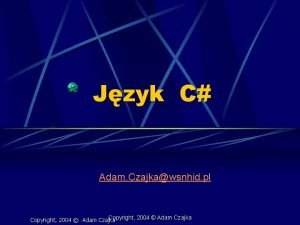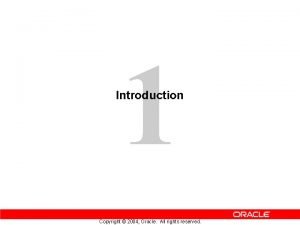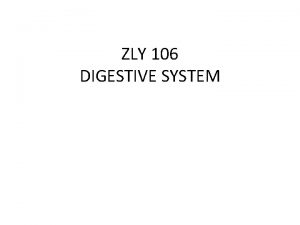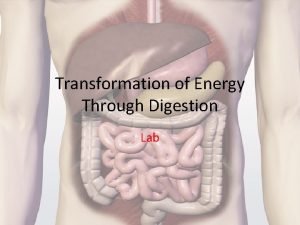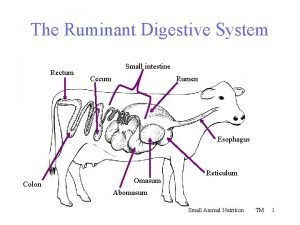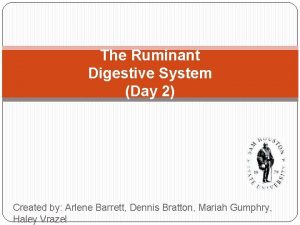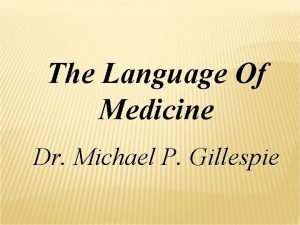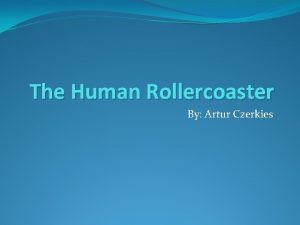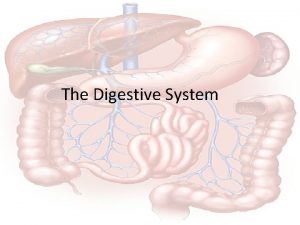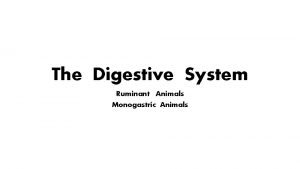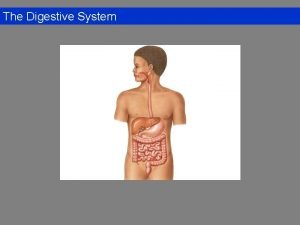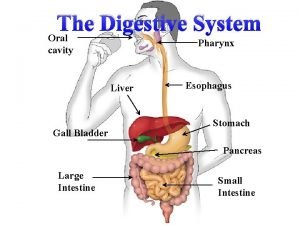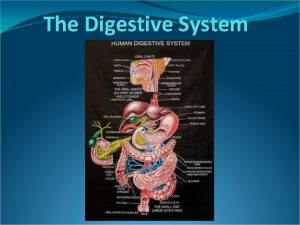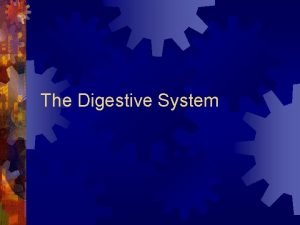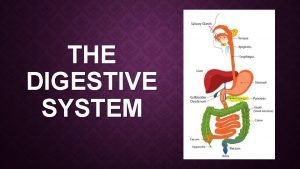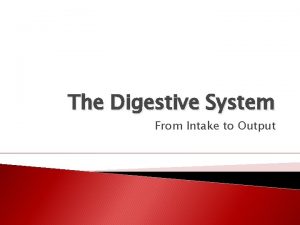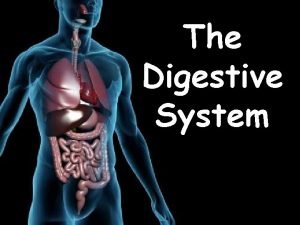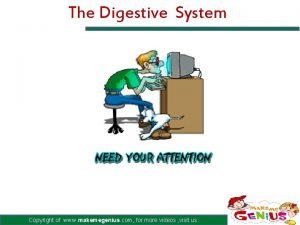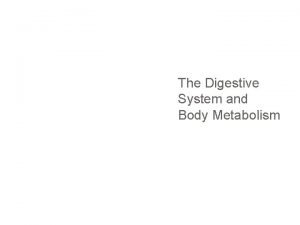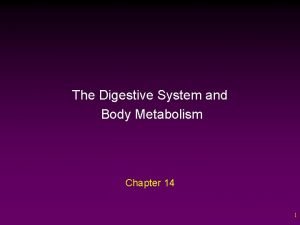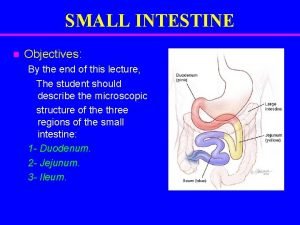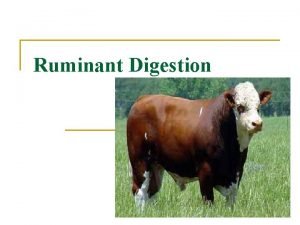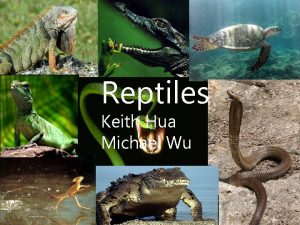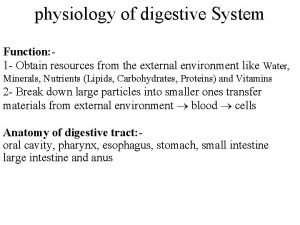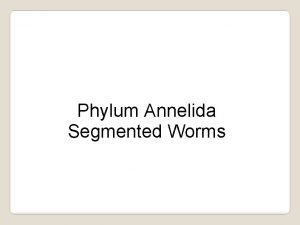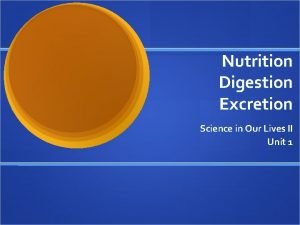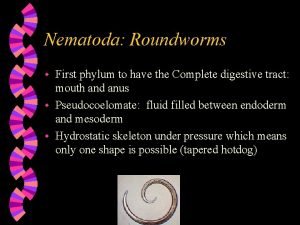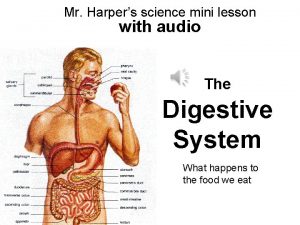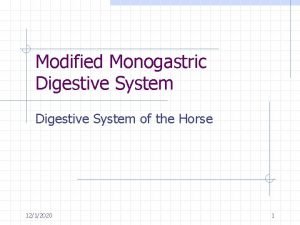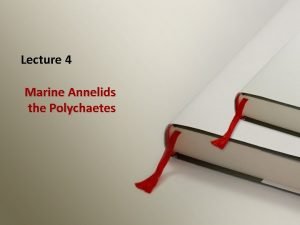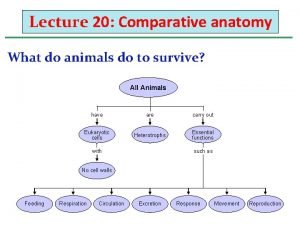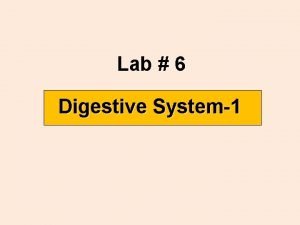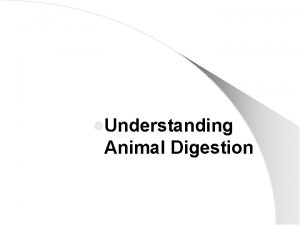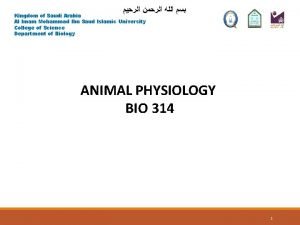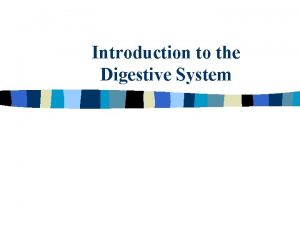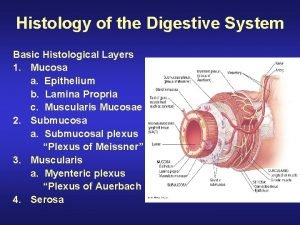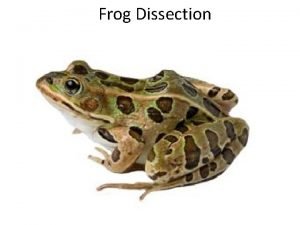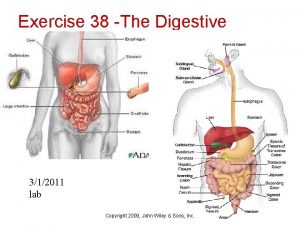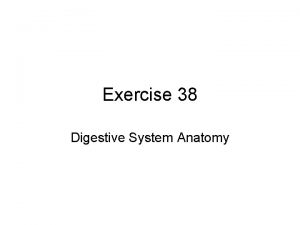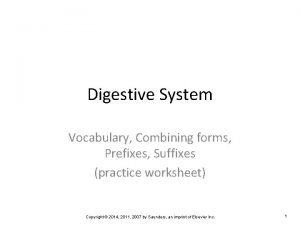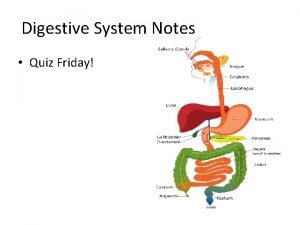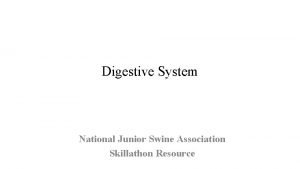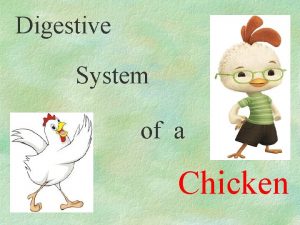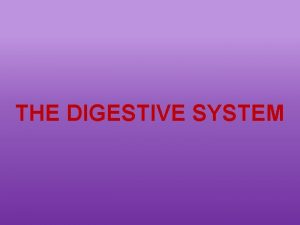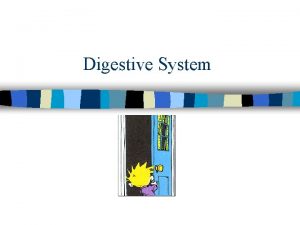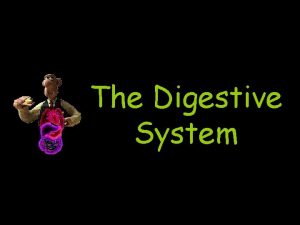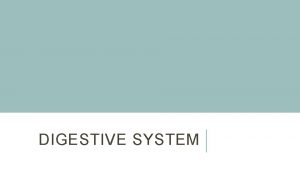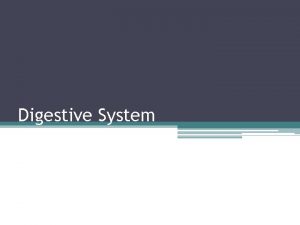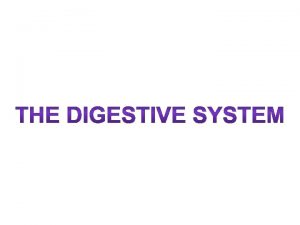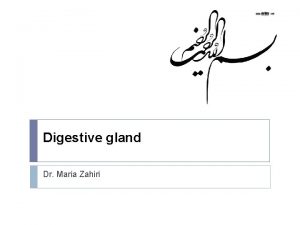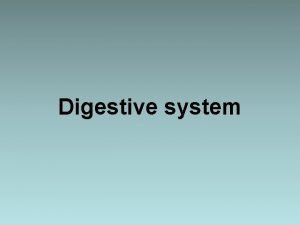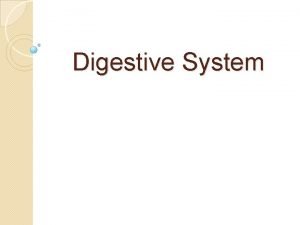The Components of the Digestive System Copyright 2004





![]The Regulation of Digestive Activities Copyright © 2004 Pearson Education, Inc. , publishing as ]The Regulation of Digestive Activities Copyright © 2004 Pearson Education, Inc. , publishing as](https://slidetodoc.com/presentation_image/5315ee98ac9a102c9dd1092b09390c3f/image-6.jpg)

























































- Slides: 63

The Components of the Digestive System Copyright © 2004 Pearson Education, Inc. , publishing as Benjamin Cummings Figure 24. 1

Functions of the digestive system • Ingestion • Mechanical processing • Digestion • Secretion • Absorption • Excretion Copyright © 2004 Pearson Education, Inc. , publishing as Benjamin Cummings

Movement of digestive materials • Visceral smooth muscle shows rhythmic cycles of activity • Pacemaker cells • Peristalsis • Waves that move a bolus • Segmentation • Churn and fragment a bolus Copyright © 2004 Pearson Education, Inc. , publishing as Benjamin Cummings

Peristalsis Copyright © 2004 Pearson Education, Inc. , publishing as Benjamin Cummings Figure 24. 4

Control of the digestive system • Movement of materials along the digestive tract is controlled by: • Neural mechanisms • Hormonal mechanisms • Enhance or inhibit smooth muscle contraction • Local mechanisms • Coordinate response to changes in p. H or chemical stimuli Copyright © 2004 Pearson Education, Inc. , publishing as Benjamin Cummings
![The Regulation of Digestive Activities Copyright 2004 Pearson Education Inc publishing as ]The Regulation of Digestive Activities Copyright © 2004 Pearson Education, Inc. , publishing as](https://slidetodoc.com/presentation_image/5315ee98ac9a102c9dd1092b09390c3f/image-6.jpg)
]The Regulation of Digestive Activities Copyright © 2004 Pearson Education, Inc. , publishing as Benjamin Cummings Figure 24. 5

The mouth opens into the oral or buccal cavity • Its functions include: • Analysis of material before swallowing • Mechanical processing by the teeth, tongue, and palatal surfaces • Lubrication • Limited digestion Copyright © 2004 Pearson Education, Inc. , publishing as Benjamin Cummings

Anatomy of the Mouth and Throat 8 Copyright © 2004 Pearson Education, Inc. , publishing as Benjamin Cummings

Human Deciduous and Permanent Teeth 9 Copyright © 2004 Pearson Education, Inc. , publishing as Benjamin Cummings

Dorsal Surface of the Tongue 10 Copyright © 2004 Pearson Education, Inc. , publishing as Benjamin Cummings

The tongue • primary functions include: • Mechanical processing • Assistance in chewing and swallowing • Sensory analysis by touch, temperature, and taste receptors Copyright © 2004 Pearson Education, Inc. , publishing as Benjamin Cummings

The pharynx • Common passageway for food, liquids, and air • Lined with stratified squamous epithelium • Pharyngeal muscles assist in swallowing • Pharyngeal constrictor muscles • Palatal muscles Copyright © 2004 Pearson Education, Inc. , publishing as Benjamin Cummings

The Esophagus Copyright © 2004 Pearson Education, Inc. , publishing as Benjamin Cummings Figure 24. 10 a-c

Deglutition (swallowing) • Sequence • Voluntary stage • Push food to back of mouth • Pharyngeal stage • Raise • Larynx + hyoid • Tongue to soft palate • Esophageal stage • Contract pharyngeal muscles • Open esophagus • Start peristalsis 14 Copyright © 2004 Pearson Education, Inc. , publishing as Benjamin Cummings

Deglutition (swallowing) • Control • Nerves • Glossopharyngeal • Vagus • Accessory • Brain stem • Deglutition center • Medulla oblongata • Pons • Disorders • Dysphagia • Aphagia 15 Copyright © 2004 Pearson Education, Inc. , publishing as Benjamin Cummings

Esophagus • Sphincters • Upper • Lower 16 Copyright © 2004 Pearson Education, Inc. , publishing as Benjamin Cummings

• Abnormalities • Achalasia – lower esophagus muscles don’t relax- doesn’t allow food to pass through • Atresia- esophogus openings are closed shut (Birth Defect) • Hernia- Esophogus pushes into stomach • Barret’s esophagus- tissue is more like intestinal lining tissue- can develop a rare cancer from this • Esophageal varices- enlarged veins that can leak blood Copyright © 2004 Pearson Education, Inc. , publishing as Benjamin Cummings

Functions of the stomach • Bulk storage of undigested food • Mechanical breakdown of food • Disruption of chemical bonds via acids and enzymes Copyright © 2004 Pearson Education, Inc. , publishing as Benjamin Cummings

Digestion and absorption in the stomach • Preliminary digestion of proteins • Pepsin • Permits digestion of carbohydrates • Very little absorption of nutrients • Some drugs, however, are absorbed • Mucous secretion containing several hormones • Enteroendocrine cells (Endocrine= Hormones!) • G cells secrete gastrin – stimulates pareital cells to secrete HCL • D cells secrete somatostatin- inhibits gastric secretions Copyright © 2004 Pearson Education, Inc. , publishing as Benjamin Cummings

The Stomach Copyright © 2004 Pearson Education, Inc. , publishing as Benjamin Cummings Figure 24. 12 b

The Stomach Lining Copyright © 2004 Pearson Education, Inc. , publishing as Benjamin Cummings Figure 24. 13 a, b

The Stomach Lining Copyright © 2004 Pearson Education, Inc. , publishing as Benjamin Cummings Figure 24. 13 c, d

Stomach Histology • • Gastric pits: openings for gastric glands. Lined with simple columnar epithelium Cells of gastric pits • Surface mucus: mucus that protects stomach lining from acid and digestive enzymes • Mucous neck: mucus • Parietal: hydrochloric acid and intrinsic factor • Chief: pepsinogen • Endocrine: regulatory hormones • Gastrin-containing cells: secrete gastrin (a hormone that stimulates acid secretion) • Somatostatin-containing cells: secrete somatostatin that inhibits gastrin and insulin secretion 24 -23 Copyright © 2004 Pearson Education, Inc. , publishing as Benjamin Cummings

Secretions of the Stomach • Chyme: ingested food plus stomach secretions • Mucus: surface and neck mucous cells • Viscous and alkaline • Protects from acidic chyme and enzyme pepsin • Irritation of stomach mucosa causes greater mucus • Intrinsic factor: parietal cells. Binds with vitamin B 12 and helps it to be absorbed in the ileum. B 12 necessary for DNA synthesis and RBC production (lack of B 12 absorption leads to pernicious anemia) 24 -24 Copyright © 2004 Pearson Education, Inc. , publishing as Benjamin Cummings

Secretions of the Stomach • HCl: parietal cells • Kills bacteria (found in ingested food) • Stops carbohydrate digestion by inactivating salivary amylase • Denatures proteins • Helps convert pepsinogen to pepsin (optimal activity at p. H 3 or less) • Pepsinogen: packaged and released by exocytosis. Pepsin catalyzes breaking of covalent bonds in proteins (breaks them into smaller peptide chains) Copyright © 2004 Pearson Education, Inc. , publishing as Benjamin Cummings

Cephalic Phase • The taste or smell of food, tactile sensations of food in the mouth, or even thoughts of food stimulate the medulla oblongata. • Parasympathetic action potentials are carried by the vagus nerves to the stomach, where enteric plexus neurons are activated. • Neurons stimulate secretion by parietal and chief cells (HCl and pepsin) and stimulate the secretion of the hormone gastrin and histamine. • Gastrin is carried through the circulation back to the stomach where it and histamine stimulate further secretion of HCl and pepsin. 24 -26 Copyright © 2004 Pearson Education, Inc. , publishing as Benjamin Cummings

Gastric Phase • Distention of the stomach activates a parasympathetic reflex. Action potentials are carried by the vagus nerves to the medulla oblongata. • Medulla oblongata stimulates further secretions of the stomach. • Distention also stimulates local reflexes that amplify stomach secretions. 24 -27 Copyright © 2004 Pearson Education, Inc. , publishing as Benjamin Cummings

Intestinal Phase 1. Chyme in the duodenum with a p. H less than 2 or containing lipids inhibits gastric secretions by three mechanisms 2. Sensory input to the medulla from the duodenum inhibits the motor input from the medulla to the stomach. Stops secretion of pepsin and HCl. 3. Local reflexes inhibit gastric secretion 4. Secretin, and cholecystokinin produced by the duodenum decrease gastric secretions in the stomach. 24 -28 Copyright © 2004 Pearson Education, Inc. , publishing as Benjamin Cummings

Movements in Stomach • Combination of mixing waves (80%) and peristaltic waves (20%) • Both esophageal and pyloric sphincters are closed. 24 -29 Copyright © 2004 Pearson Education, Inc. , publishing as Benjamin Cummings

Small intestine • Important digestive and absorptive functions • Secretions and buffers provided by pancreas, liver, gall bladder • Three subdivisions: • Duodenum • Jejunum • Ileocecal sphincter • Transition between small and large intestine Copyright © 2004 Pearson Education, Inc. , publishing as Benjamin Cummings

Figure 24. 16 Regions of the Small Intestine Copyright © 2004 Pearson Education, Inc. , publishing as Benjamin Cummings Figure 24. 16 a

Histology of the small intestine • Plicae • Transverse folds of the intestinal lining • Villi • Fingerlike projections of the mucosa • Lacteals • Terminal lymphatic in villus • Intestinal glands • Lined by enteroendocrine, goblet and stem cells Copyright © 2004 Pearson Education, Inc. , publishing as Benjamin Cummings

Modifications to Increase Surface Area • Increase surface area 600 fold • Plicae circulares (circular folds) • Villi that contain capillaries and lacteals. Folds of the mucosa • Microvilli: folds of cell membranes of absorptive cells 24 -33 Copyright © 2004 Pearson Education, Inc. , publishing as Benjamin Cummings

The Intestinal Wall Copyright © 2004 Pearson Education, Inc. , publishing as Benjamin Cummings Figure 24. 17 a

The Intestinal Wall Copyright © 2004 Pearson Education, Inc. , publishing as Benjamin Cummings Figure 24. 17 b, c

The Intestinal Wall Copyright © 2004 Pearson Education, Inc. , publishing as Benjamin Cummings Figure 24. 17 d, e

Intestinal juices • Moisten chyme • Help buffer acids • Maintain digestive material in solution Copyright © 2004 Pearson Education, Inc. , publishing as Benjamin Cummings

Mucosa and Submucosa of the Duodenum • Cells and glands of the mucosa • Absorptive cells: cells with microvilli, produce digestive enzymes and absorb digested food • Goblet cells: produce protective mucus • Endocrine cells: produce regulatory hormones (Secretin, and cholecystokinin) • Granular cells (paneth cells): may help protect from bacteria (contain lysozymes) • Intestinal glands (crypts of Lieberkühn): tubular glands in mucosa at bases of villi [secrete sucrase , maltase, trypsin, chymotrypsin, and pepsin (endopeptidases and exopeptidases) ] • Duodenal glands (Brunner’s glands): tubular mucous glands of the submucosa. Open into intestinal glands [produce a mucus-rich alkaline secretion (containing bicarbonate) 24 -38 Copyright © 2004 Pearson Education, Inc. , publishing as Benjamin Cummings

Jejunum and Ileum • Gradual decrease in diameter, thickness of intestinal wall, number of circular fold, and number of villi the farther away from the stomach • Major site of nutrient absorption • Peyer’s patches: lymphatic nodules numerous in mucosa and submucosa • Ileocecal junction: where ileum meets large intestine. Ileocecal sphincter (ring of smooth muscle) and ileocecal valve (one-way valve) 24 -39 Copyright © 2004 Pearson Education, Inc. , publishing as Benjamin Cummings

Liver, Gallbladder, Pancreas and Ducts 24 -40 Copyright © 2004 Pearson Education, Inc. , publishing as Benjamin Cummings

The Pancreas Copyright © 2004 Pearson Education, Inc. , publishing as Benjamin Cummings Figure 24. 18 a-c

Pancreatic Secretions: Pancreatic Juice • Enzymatic portion: (without the enzymes produced by pancreas, lipids, proteins, & carbs not adequately digested) • • • Trypsinogen- active form is trypsin----proteolytic enzyme Chymotrypsinogen- active form is chymotrypsin----proteolytic enzyme Procarboxypeptidase- active form is carboxypeptidase-------proteolytic enzyme Pancreatic amylase- continues digestion of starch. Pancreatic lipases- lipid digesting enzyme Deoxyribonucleases and ribonucleases- reduce DNA & RNA to their nucleotide • Interaction of duodenal and pancreatic enzymes • Enterokinase is a proteolytic enzyme from the duodenal mucosa and it activates trypsinogen to trypsin. • Trypsin activates chymotrypsinogen to chymotrypsin. • Trypsin activates procarboxypeptidase to carboxypeptidase. 24 -42 Copyright © 2004 Pearson Education, Inc. , publishing as Benjamin Cummings

Liver Histology • Hepatic cords: radiate out from central vein. Composed of hepatocytes • Hepatic sinusoids: between cords, lined with endothelial cells and hepatic phagocytic (Kupffer) cells • Bile canaliculus: between cells within cords • Hepatocyte functions • Bile production • Storage • Interconversion of nutrients • Detoxification • Synthesis of blood components Copyright © 2004 Pearson Education, Inc. , publishing as Benjamin Cummings 24 -43

Functions of the Liver • Bile production: 600 -1000 m. L/day. Bile salts, bilirubin (bile pigment that results from breakdown of hemoglobin), cholesterol, fats, fat-soluble hormones, lecithin • Neutralizes and dilutes stomach acid (neutralizes chyme so that pancreatic enzymes can function) • Bile salts emulsify fats. Most are reabsorbed in the ileum. (90% bile salts reabsorbed in the ileum & carried back to liver) • Secretin (from the duodenum) stimulates bile secretions, increasing water and bicarbonate ion content of the bile • Storage • Glycogen, fat, vitamins (A, B 12, D, E, and K), copper and iron. Hepatic portal blood comes to liver from small intestine (nutrients are stored and secreted back into circulation when needed) • Synthesis • Blood proteins: Albumins, fibrinogen, globulins, heparin, clotting factors (liver produces its own new compounds) 24 -44 Copyright © 2004 Pearson Education, Inc. , publishing as Benjamin Cummings

Liver • Lobes • Major: Left and right • Minor: Caudate and quadrate • Porta: on inferior surface. Vessels, ducts, nerves, exit/enter liver • Hepatic portal vein, hepatic artery, hepatic nerve plexus enter • Lymphatic vessels, two hepatic ducts exit • Ducts –Right and left hepatics (which transport bile out of liver) unite to form –Common hepatic –Cystic: from gallbladder –Common bile: union of cystic duct and common hepatic duct 24 -45 Copyright © 2004 Pearson Education, Inc. , publishing as Benjamin Cummings

The Anatomy of the Liver Copyright © 2004 Pearson Education, Inc. , publishing as Benjamin Cummings Figure 24. 19 b, c

Liver Histology Copyright © 2004 Pearson Education, Inc. , publishing as Benjamin Cummings Figure 24. 20 a, b

The gallbladder • Hollow, pear-shaped organ • Stores, modifies and concentrates bile Copyright © 2004 Pearson Education, Inc. , publishing as Benjamin Cummings

The Gallbladder Copyright © 2004 Pearson Education, Inc. , publishing as Benjamin Cummings Figure 24. 21 a, b

Large Intestine • Extends from ileocecal junction to anus • Consists of cecum, colon, rectum, anal canal • Movements sluggish (18 -24 hours); chyme converted to feces. • Absorption of water and salts, secretion of mucus, extensive action of microorganisms are involved in the formation of feces. • 1500 m. L chyme enter the cecum, 90% of volume reabsorbed yielding 80 -150 m. L of feces Copyright © 2004 Pearson Education, Inc. , publishing as Benjamin Cummings 24 -50

The Large Intestine Copyright © 2004 Pearson Education, Inc. , publishing as Benjamin Cummings Figure 24. 23 a

Anatomy of Large Intestine • Cecum • Blind sac, appendix attached. Appendix walls contain numerous lymph nodules • Colon • Ascending, transverse, descending, sigmoid • Mucosa has numerous straight tubular glands called crypts. Goblet cells predominate, but there also absorptive and granular cells as in the small intestine 24 -52 Copyright © 2004 Pearson Education, Inc. , publishing as Benjamin Cummings

The Large Intestine Copyright © 2004 Pearson Education, Inc. , publishing as Benjamin Cummings Figure 24. 23 b, c

Anatomy of Large Intestine • Rectum • Straight muscular tube, thick muscular tunic • Anal canal- superior epithelium is simple columnar; inferior epithelium is stratified squamous • Internal anal sphincter (smooth muscle) • External anal sphincter (skeletal muscle) • Hemorrhoids: Vein enlargement or inflammation 24 -54 Copyright © 2004 Pearson Education, Inc. , publishing as Benjamin Cummings

Secretions of Large Intestine • Mucus provides protection • Pumps: bacteria remove acid from the epithelial cells that line the large intestine • Bacteria produce gases (flatus) from particular kinds of carbohydrates found in legumes and in artificial sugars like sorbitol • Bacteria produce vitamin K which is then absorbed • Feces consists of water, undigested food (cellulose), microorganisms, sloughed-off epithelial cells 24 -55 Copyright © 2004 Pearson Education, Inc. , publishing as Benjamin Cummings

Movement in Large Intestine • Mass movements (strong contractions) • Common after meals • Local reflexes instigated by the presence of food in the stomach and duodenum • Gastrocolic: initiated by stomach • Duodenocolic: initiated by duodenum • Defecation reflex: distension of the rectal wall by feces • Parasympathetic stimulation • Usually accompanied by voluntary movements to expel feces. Abdominal cavity pressure caused by inspiration and by contraction of muscles of abdominal wall. 24 -56 Copyright © 2004 Pearson Education, Inc. , publishing as Benjamin Cummings

Histology of the large intestine • Absence of villi • Presence of goblet cells • Deep intestinal glands Copyright © 2004 Pearson Education, Inc. , publishing as Benjamin Cummings

The Defecation Reflex Copyright © 2004 Pearson Education, Inc. , publishing as Benjamin Cummings Figure 24. 25

Carbohydrate digestion and absorption • Begins in the mouth • Salivary and pancreatic enzymes • Disaccharides and trisaccharides • Brush border enzymes • Monosaccharides • Absorption of monosaccharides occurs across the intestinal epithelia Copyright © 2004 Pearson Education, Inc. , publishing as Benjamin Cummings

Lipid digestion and absorption • Lipid digestion utilizes lingual and pancreatic lipases • Bile salts improve chemical digestion by emulsifying lipid drops • Lipid-bile salt complexes called micelles are formed • Micelles diffuse into intestinal epithelia which release lipids into the blood as chylomicrons Copyright © 2004 Pearson Education, Inc. , publishing as Benjamin Cummings

Protein digestion and absorption • Low p. H destroys tertiary and quaternary structure • Enzymes used include pepsin, trypsin, chymotrypsin, and elastase • Liberated amino acids are absorbed Copyright © 2004 Pearson Education, Inc. , publishing as Benjamin Cummings

Absorption • Water • Nearly all that is ingested is reabsorbed via osmosis • Ions • Absorbed via diffusion, cotransport, and active transport • Vitamins • Water soluble vitamins are absorbed by diffusion • Fat soluble vitamins are absorbed as part of micelles • Vitamin B 12 requires intrinsic factor Copyright © 2004 Pearson Education, Inc. , publishing as Benjamin Cummings

Digestive Secretion and Absorption of Water Copyright © 2004 Pearson Education, Inc. , publishing as Benjamin Cummings Figure 24. 27
 Copyright 2004
Copyright 2004 Ejemplos de bienes publicos
Ejemplos de bienes publicos Copyright 2004
Copyright 2004 Konsep biaya hidup
Konsep biaya hidup Copyright 2004
Copyright 2004 Curva de oferta a largo plazo de una empresa competitiva
Curva de oferta a largo plazo de una empresa competitiva 2004
2004 Copyright 2004
Copyright 2004 Nesova ravnoteza
Nesova ravnoteza Légende amérindienne sirop d érable
Légende amérindienne sirop d érable Copyright 2004
Copyright 2004 Copyright 2004
Copyright 2004 Site:slidetodoc.com
Site:slidetodoc.com Nervous system and digestive system
Nervous system and digestive system Sheep ruminant digestive system
Sheep ruminant digestive system Monogastric
Monogastric Energy transformation in digestion
Energy transformation in digestion Digestive system of ruminants
Digestive system of ruminants Ruminant digestive system
Ruminant digestive system Ruminant stomach
Ruminant stomach øhuman digestive system
øhuman digestive system Digestive system roller coaster
Digestive system roller coaster Digestive system facts
Digestive system facts Pig digestive system
Pig digestive system Serosa vs adventitia
Serosa vs adventitia Pharynx in digestive system
Pharynx in digestive system Introduction about digestive system
Introduction about digestive system Intestinal glands
Intestinal glands Pepto bysmol
Pepto bysmol Digestive system output
Digestive system output Digestive system
Digestive system Turtle digestive system
Turtle digestive system Www.make me genius.com digestive system
Www.make me genius.com digestive system Figure 14-1 digestive system
Figure 14-1 digestive system Alartine
Alartine Biggest muscle in human body
Biggest muscle in human body Plicae digestive system
Plicae digestive system What is this
What is this Snake heart
Snake heart Frog digestive system
Frog digestive system Cnidaria digestive tract
Cnidaria digestive tract Ganglia in annelida
Ganglia in annelida Digestive system order
Digestive system order Jblem
Jblem Correct order of digestive system
Correct order of digestive system Modified monogastric
Modified monogastric Polychaete circulatory system
Polychaete circulatory system Invertebrate digestive system
Invertebrate digestive system Agnatha
Agnatha The microscopic structure of the small intestine
The microscopic structure of the small intestine Avian digestive system
Avian digestive system øhuman digestive system
øhuman digestive system Diagram of pig digestive system
Diagram of pig digestive system Digestive system introduction
Digestive system introduction Annotated diagram of the digestive system
Annotated diagram of the digestive system Duodenum cell
Duodenum cell Muscularis mucosa
Muscularis mucosa Frog artery
Frog artery Exercise 38 review sheet art-labeling activity 2
Exercise 38 review sheet art-labeling activity 2 Teeth formula
Teeth formula Ectasia suffix
Ectasia suffix Abnormal tube like passageway near the anus
Abnormal tube like passageway near the anus Pig digestive system diagram
Pig digestive system diagram Digestive system jeopardy
Digestive system jeopardy
